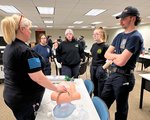REGION — Kassie Thelman went to SUNY Sullivan, but wasn’t sure what she wanted to study.
“Then I had Professor Armstrong,” and found environmental science, she said.
…
Stay informed about your community and support local independent journalism.
Subscribe to The River Reporter today. click here
This item is available in full to subscribers.
Please log in to continueNeed an account?
|


REGION — Kassie Thelman went to SUNY Sullivan, but wasn’t sure what she wanted to study.
“Then I had Professor Armstrong,” and found environmental science, she said.
A Sullivan West graduate, she had been steered by the high school to SUNY Sullivan’s honors program, and her time at the local community college “was a really great experience,” she said.
From there, she went to SUNY Binghamton, majoring in environmental planning. After years with Advance Testing in Goshen, NY, she’s now the new recycling coordinator for Sullivan County.
That’s one path for students at two-year colleges.
Here’s another: Over in Scranton, PA, at Johnson College of Technology, students learn the high-tech skills needed by industry these days—giving them a pipeline to jobs that start between $20 and $50 an hour.
“They learn the skills that make these industries move,” said Bill Burke, vice president of enrollment and student affairs.
Some disregard two-year schools. The majority of people who attend college are in four-year programs. But a recession looms, and the price of four-year tuition has skyrocketed—at public colleges, the rate shot up 31.4 percent between 2010 and 2020.
Two-year colleges cost far less—on average, less than a third of the annual cost at four-year public colleges, according to educationaldata.org.
Historically, said SUNY Sullivan president Jay Quaintance, the reason students choose a two-year school isn’t because of a lack of ability or poor preparation.
“It’s the kind of barriers that affect all aspects of life,” he said. Think money, think other commitments—perhaps the student has a family, or is caring for elders. Think work—maybe the student is employed full-time, or is needed in a family business.
Two-year colleges can schedule around people’s lives, Quaintance said. Hybrid learning. Saturday classes. Evening classes. And SUNY Sullivan offers child care during regular school hours.
The college offers classes in the liberal arts, math and science, psychology and education—and training in hospitality, health services and wellness. There’s a sustainability track, teaching students to design, build and maintain sustainable buildings and renewable energy systems.
Credits can transfer to four-year colleges.
The courses can be a boon to working adults, Quaintance said. “[Workers] want additional skills, they’re upwardly mobile… it doesn’t mean completing a degree,” but classes can serve as micro-credentials—knowledge that the students use on the job, or in the job they want, and “attained in a reasonable amount of time,” he said.
Not everyone wants to go the academic route. Johnson College is a private, nonprofit technical college, and its programs focus on employment. Eighty percent of its students already have a job, but they’re looking to improve their skills or prospects. “Our careers are recession-proof and pandemic-proof,” Burke said. “We have great partnerships with industry.”
Although it’s located in Scranton, the college is open to students in Wayne and Pike, or in New York State.
Johnson College offers associate’s degrees in health and animal sciences, construction and electronics. Or there’s “mechatronics,” which trains students to work with electronic devices, fabrication technology, electro-mechanical systems and industry 4.0—smart factories and the engineering that keeps them going.
That includes automation and robotics.
“It’s the future of manufacturing, the future of industry,” Burke said. Companies “need high-skilled workers.”
Industrial jobs can be done by men or women, he said. “One hundred percent.”
Access to college—including two-year schools—correlates strongly with better health, better jobs (many jobs require a college degree just to get in the door), and more money in the long run, Quaintance said. “It’s an economic driver. You see greater skill levels.”
He highlighted the Sullivan Promise scholarship, which offers county residents with a high school diploma or GED the chance to receive free tuition and free fees at SUNY Sullivan.
Two-year schools are also about the future of work. Burke said that in the course of his job, he has toured many industries. “The technology these companies use is amazing.”
While students want to learn, the distances involved can cause problems. Johnson offers a distance learning program—classes can be taken at home, or partly at home. Technology offers possibilities: special headsets can let a distance-learning student follow what’s going on under a car’s hood.
Lab work, though, can involve equipment that’s not readily available. So Johnson just received a grant to partner with local school districts. It’s a distance-learning program that takes advantage of schools’ equipment. For example, “there’s welding at Wallenpaupack,” Burke said. (The college also offers early-college programs open to high school students.)
Johnson is also putting together two mobile trailers that will bring specialized equipment to students in Wayne or Pike. One trailer will focus on STEM [science, technology, engineering and math], and one will be dedicated to the building trades.
“We can bring our labs right to those areas,” he said.
“Since the mid-’70s, state and local government investment has decreased,” Quaintance said. The student loan industry has stepped in, and college debt, according to the Brookings Institution, is now the second-largest source of household debt after mortgages.
Investing in two-year programs would improve health outcomes, economic outcomes, could keep young people from leaving, Quaintance said.
At the student level, “money and time can be a barrier,” Burke said. Students “may think ‘I can’t afford it.’ They should talk to us.”
Community colleges are “the best way to lead to improved lives,” Quaintance said. “If we’re going to access all the benefits… healthier communities, driving down the cost of health care, we have to start with access to higher education.”
Related stories

Comments
No comments on this item Please log in to comment by clicking here